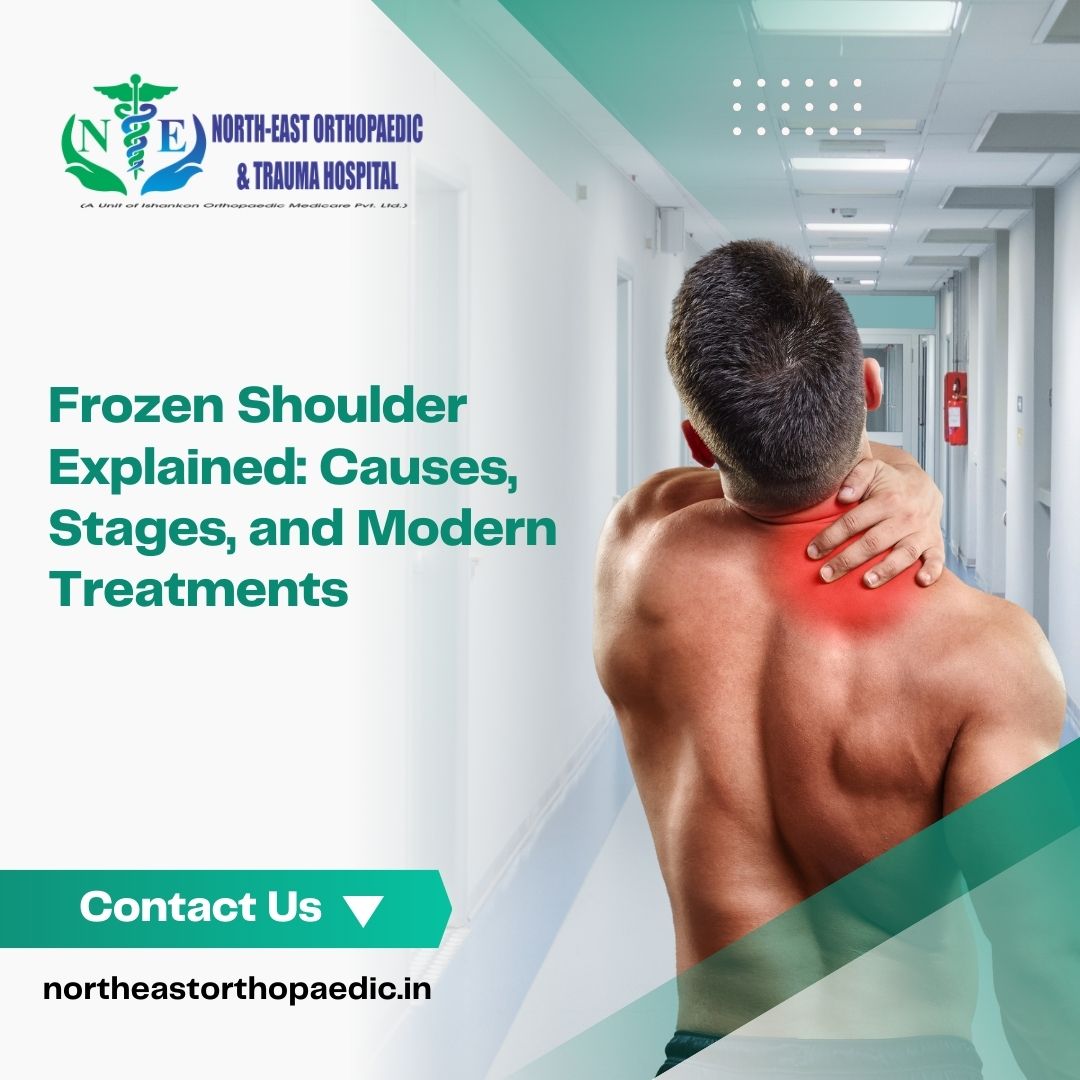Frozen shoulder is a common problem that can cause pain and stiffness in the shoulder joint. Many people who face this condition find it difficult to move their shoulder, and even simple tasks like combing hair, wearing clothes, or reaching for something become painful. In medical terms, frozen shoulder is also known as adhesive capsulitis.
In this blog, we will explain what frozen shoulder is, the main causes, the stages of the condition, and the modern treatments available.
What Is Frozen Shoulder?
The shoulder joint is like a ball and socket that allows free movement of the arm. It is surrounded by a capsule, which is a soft tissue that keeps the joint stable. In frozen shoulder, this capsule becomes thick, tight, and inflamed. Over time, scar tissue develops, and the shoulder becomes very stiff.
This makes movement painful and difficult. In many cases, frozen shoulder gets better on its own, but it may take a long time if not treated properly.
Causes of Frozen Shoulder
Doctors are still researching why frozen shoulder happens, but some factors increase the risk:
- Injury or Surgery – If you have had a shoulder injury or surgery and keep your shoulder still for a long time, stiffness may develop.
- Medical Conditions – People with diabetes, thyroid disorders, heart disease, or Parkinson’s disease are more likely to develop frozen shoulder.
- Age and Gender – Frozen shoulder is most common in people between 40 and 60 years old, and it is seen more in women than men.
- Lack of Movement – Long periods of immobility due to fractures, strokes, or other health issues can also lead to frozen shoulder.
Stages of Frozen Shoulder
Frozen shoulder usually develops slowly in three stages. Each stage can last for months.
- Freezing Stag
- Pain starts slowly and increases over time.
- Shoulder movement becomes more difficult.
- This stage may last 6 to 9 months.
- Frozen Stage
- Pain may reduce, but stiffness becomes worse.
- It is very hard to move the shoulder.
- Daily activities are more challenging.
- This stage may last 4 to 6 months.
- Thawing Stage
- The stiffness slowly reduces.
- Movement begins to improve.
- Shoulder starts returning to normal.
- This stage may last 6 months to 2 years.
The full cycle of frozen shoulder can last from 1 to 3 years without proper treatment.
Symptoms of Frozen Shoulder
Some common signs include:
- Constant shoulder pain, especially at night.
- Stiffness in the shoulder joint.
- Limited movement, even when trying to raise the arm.
Difficulty in doing regular activities like lifting, reaching, or dressing.
Modern Treatments for Frozen Shoulder
While frozen shoulder may get better on its own, modern treatment options help speed recovery and reduce pain.
- Medications
Doctors often suggest painkillers or anti-inflammatory medicines to control pain and swelling.
- Physical Therapy
This is one of the most effective treatments. Exercises help stretch the shoulder joint and improve movement. A physiotherapist can guide patients with safe exercises to slowly regain mobility.
- Heat Therapy and Cold Therapy
Applying heat pads relaxes stiff muscles, while ice packs reduce swelling. Many patients use both for relief.
- Steroid Injections
If the pain is severe, doctors may recommend injections to reduce inflammation in the shoulder.
- Hydrodilatation
This is a modern treatment where sterile water is injected into the joint capsule to stretch it and improve movement.
- Surgery (in rare cases)
When other treatments fail, doctors may recommend arthroscopic surgery. In this procedure, tight parts of the joint capsule are released using small instruments. Surgery is usually the last option and only needed in severe cases.
Tips for Self-Care at Home
- Do gentle stretching exercises daily as advised by a doctor.
- Avoid sudden heavy movements that may cause more pain.
- Apply warm compresses before exercise to relax the joint.
- Maintain a healthy lifestyle, especially if you have diabetes or thyroid problems, as these can make frozen shoulder worse.
Summary
Frozen shoulder is painful and frustrating, but the good news is that it can be treated. With the right combination of medication, physiotherapy, and sometimes modern techniques like hydrodilatation, patients can get back to normal life.
If you notice stiffness and pain in your shoulder that does not improve, you should not ignore it. Early treatment helps in faster recovery and prevents long-term problems.
By understanding the causes, stages, and treatment options, you can take the right steps to manage frozen shoulder effectively.

